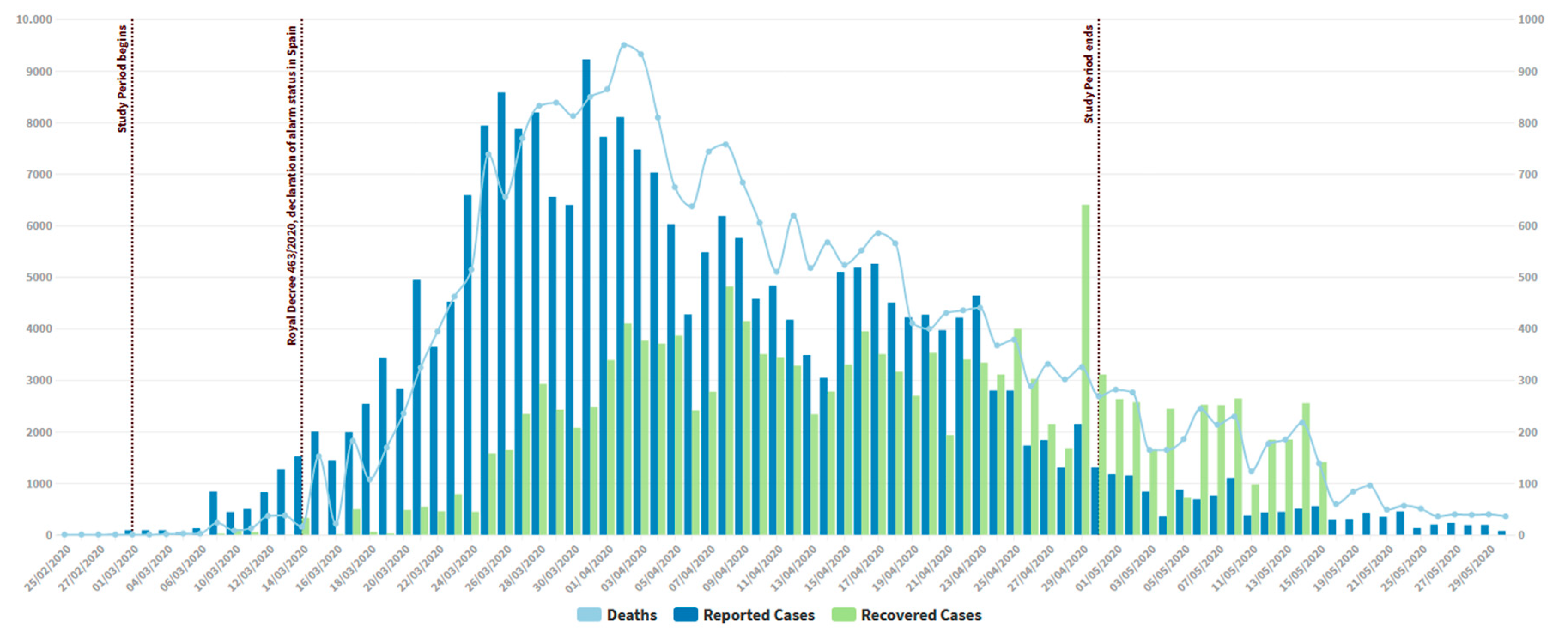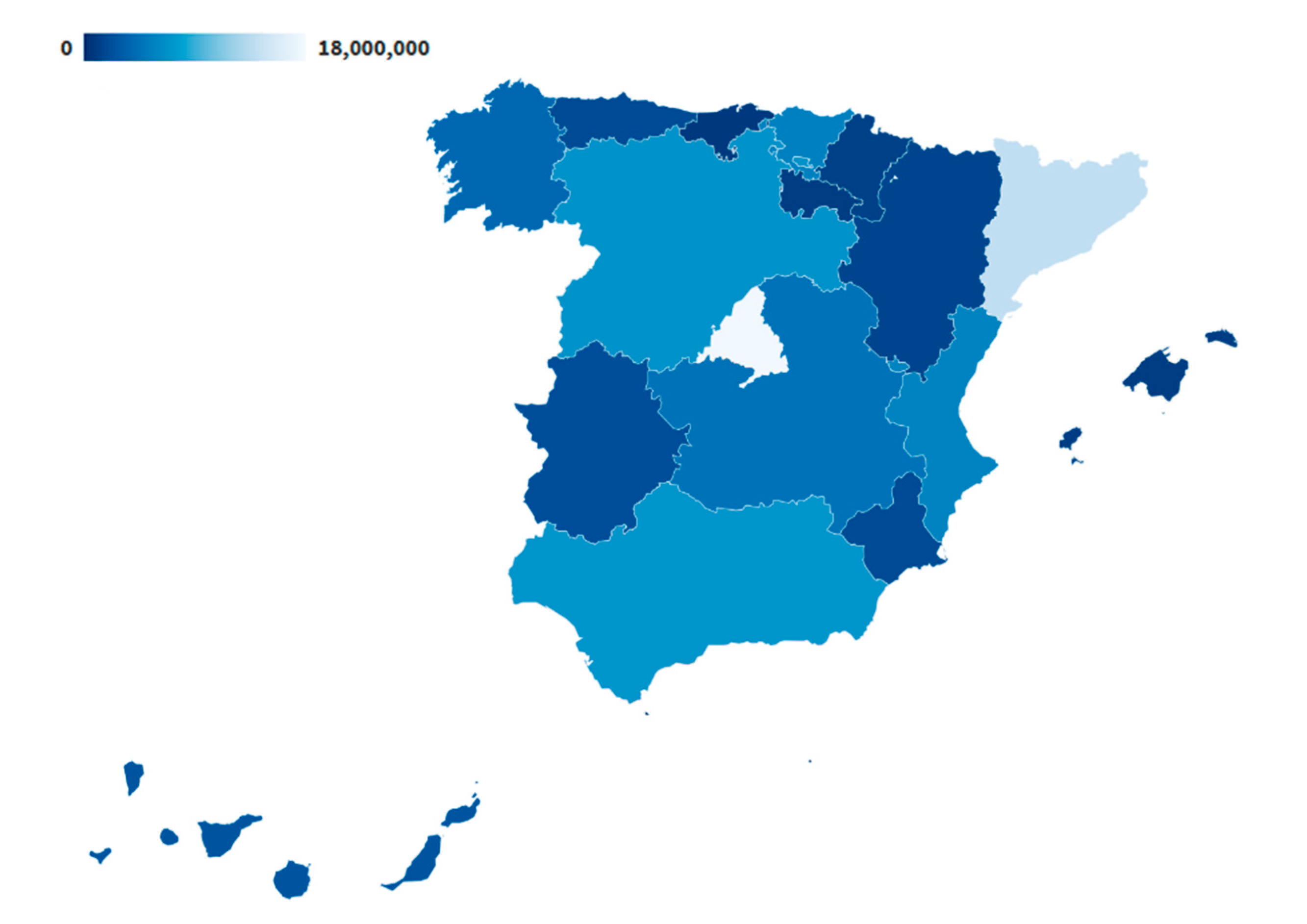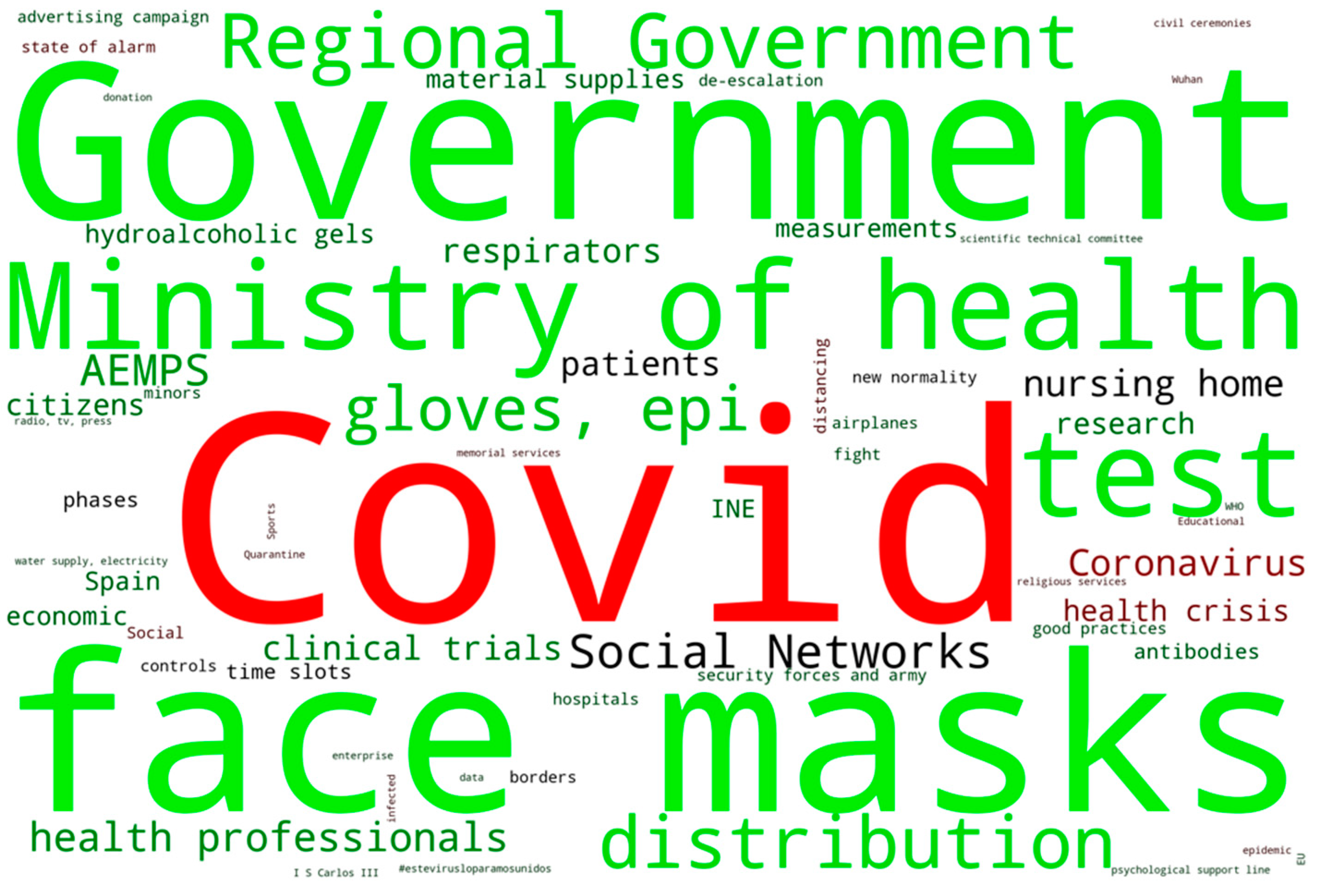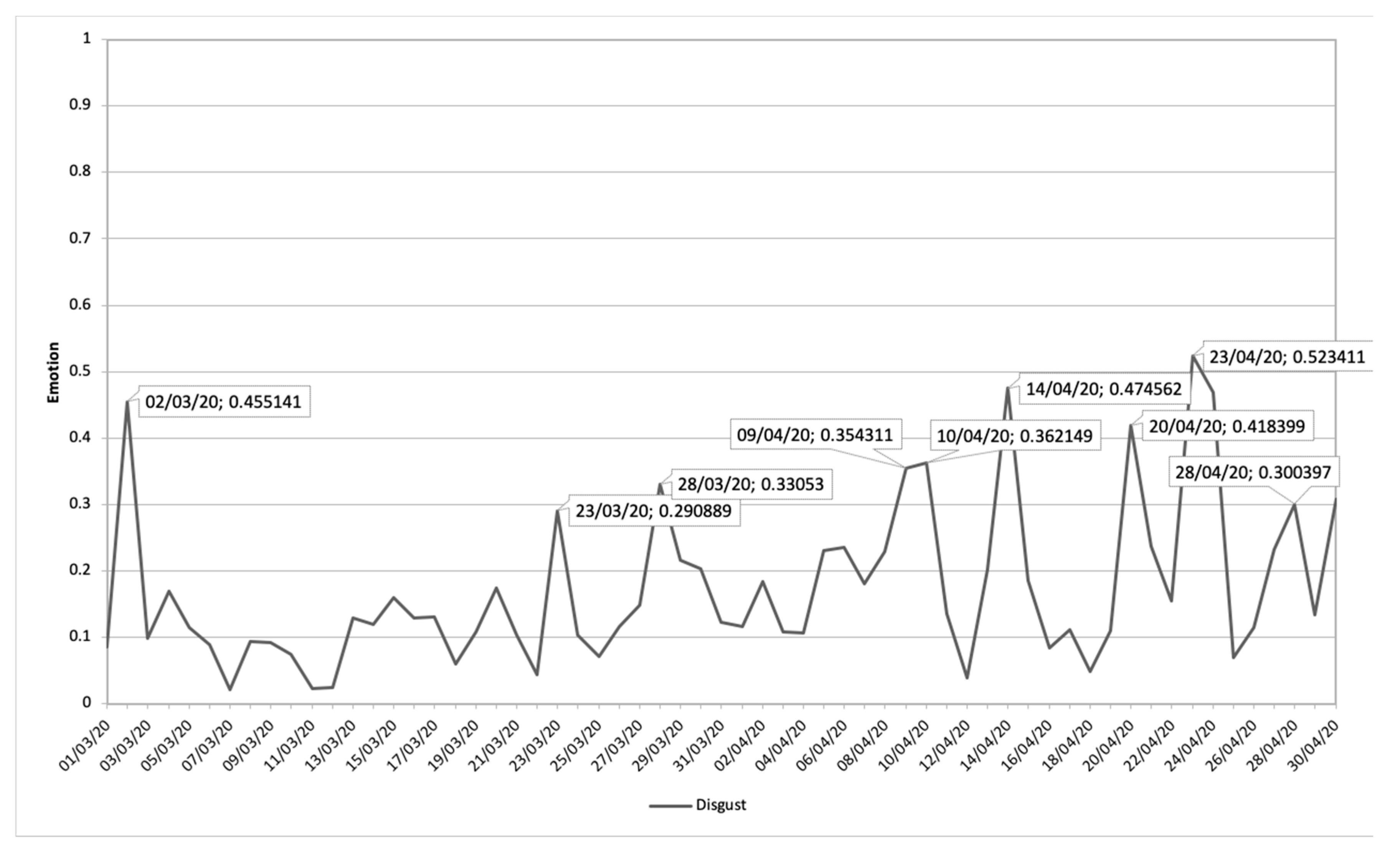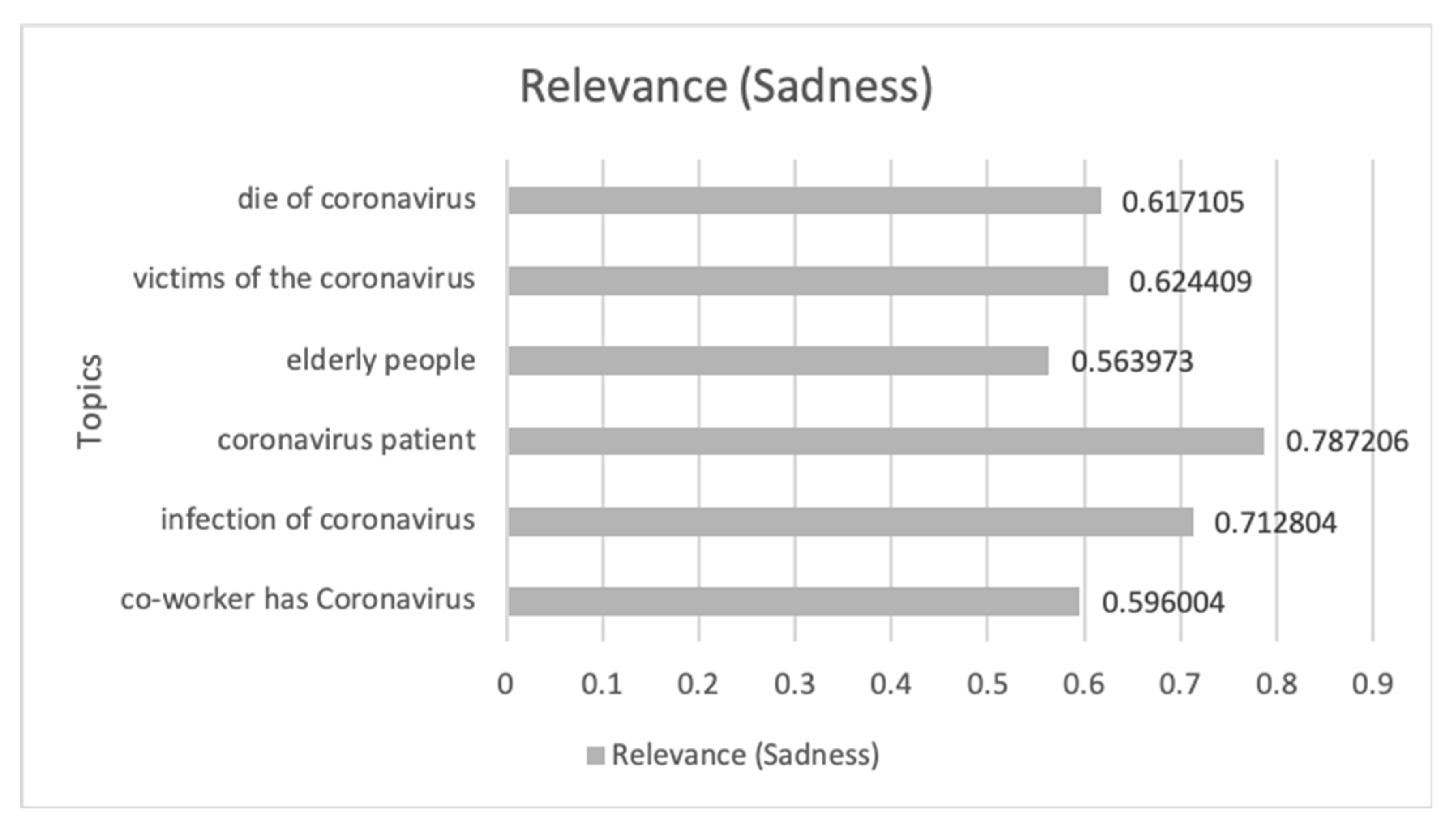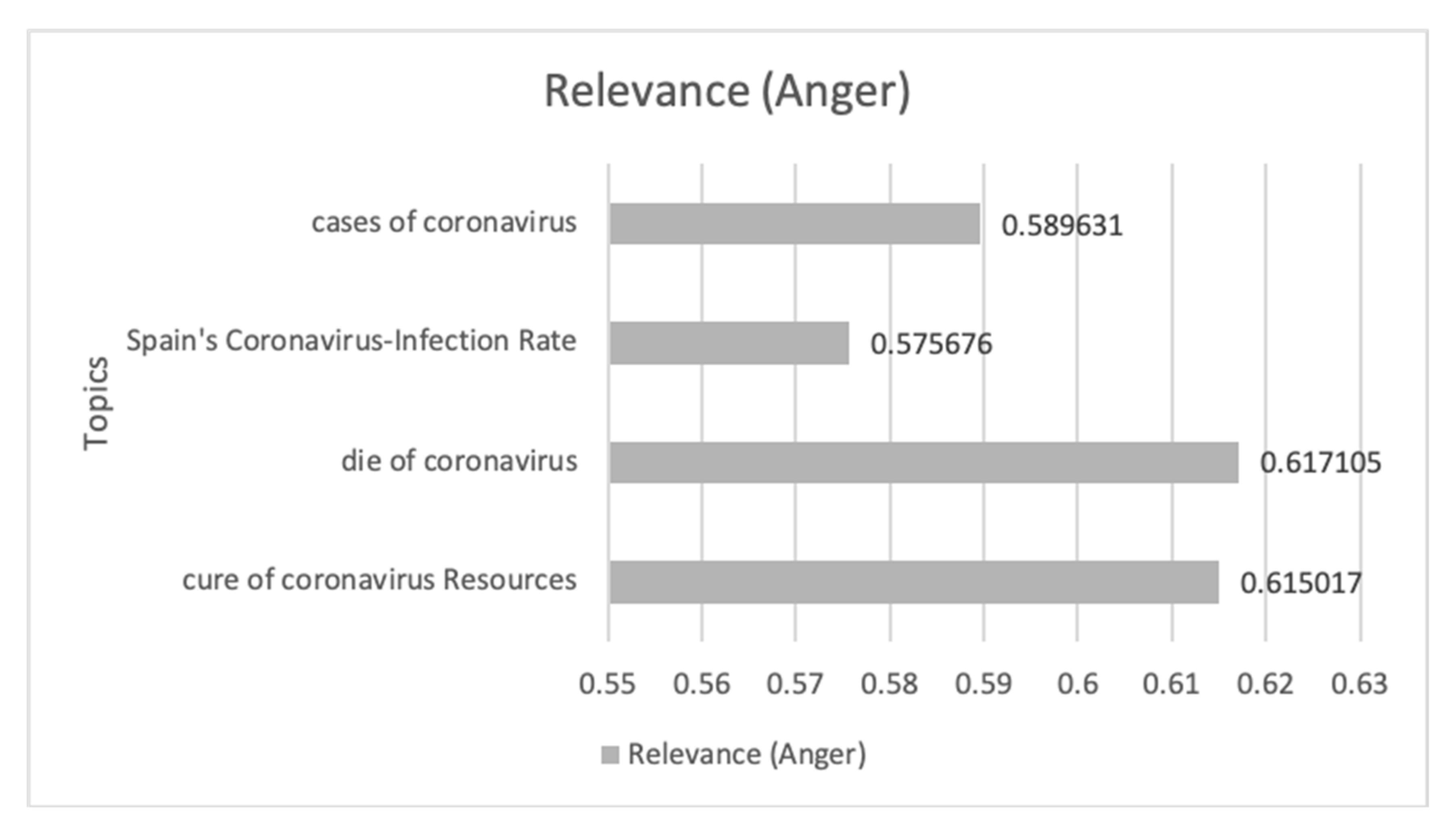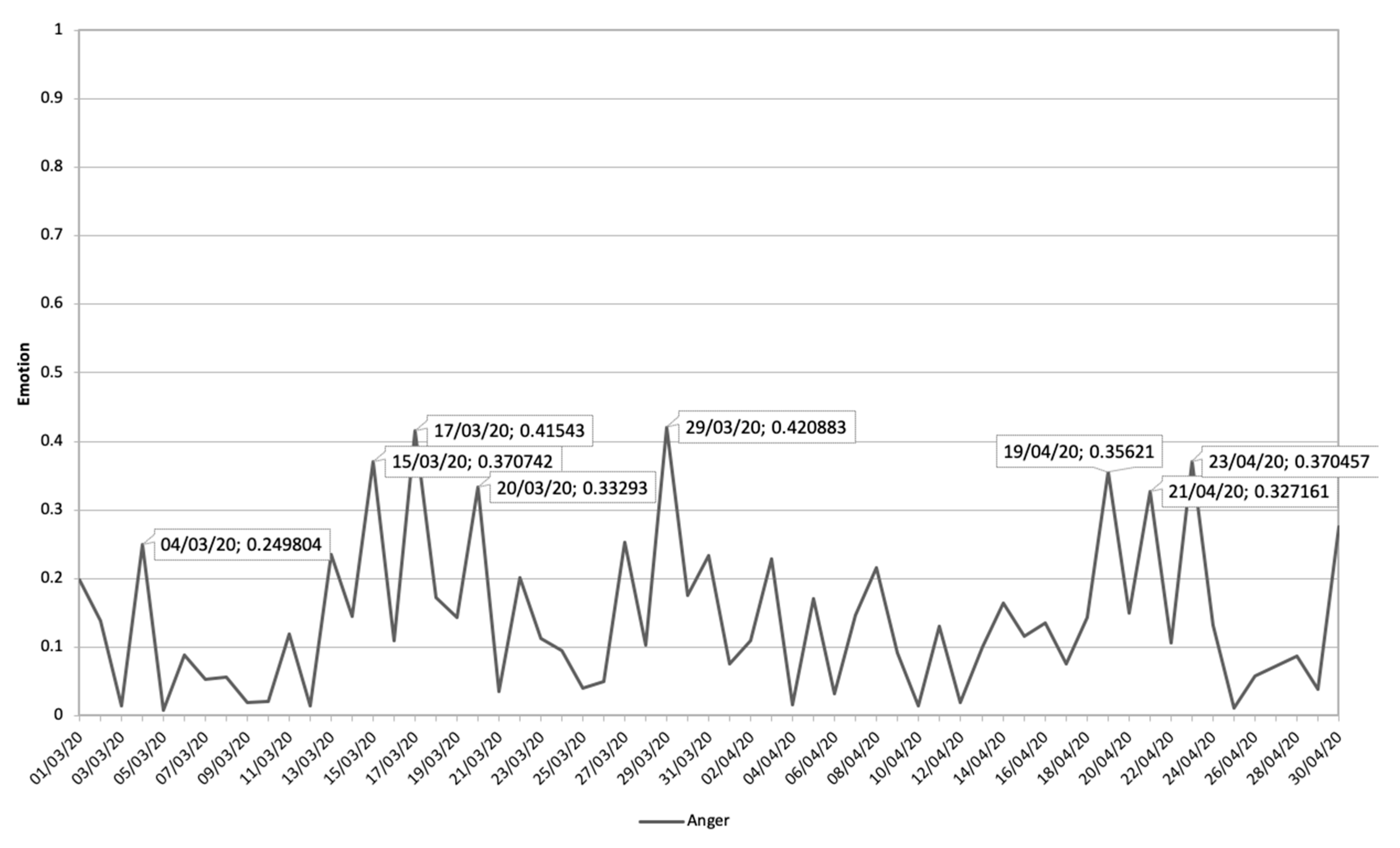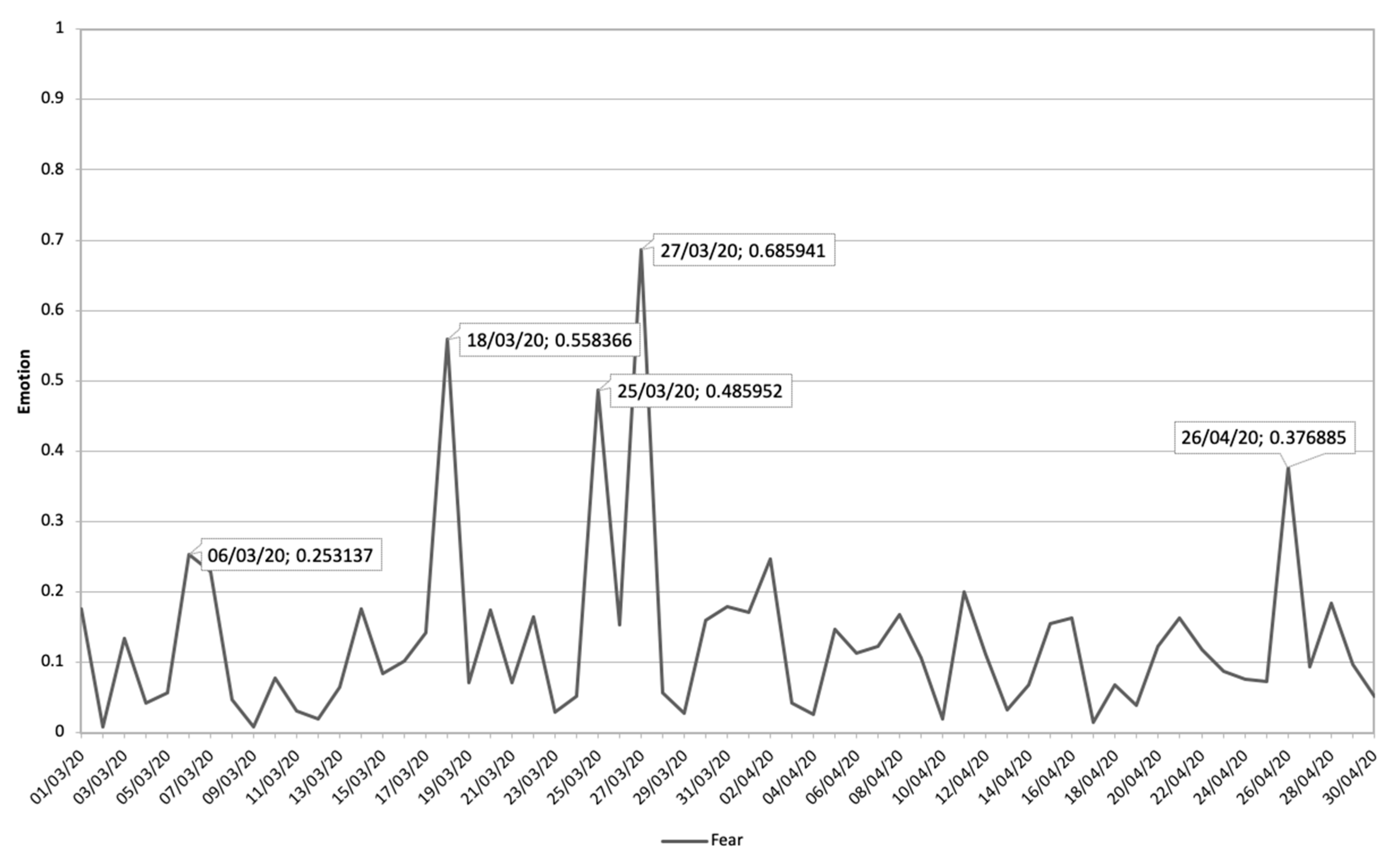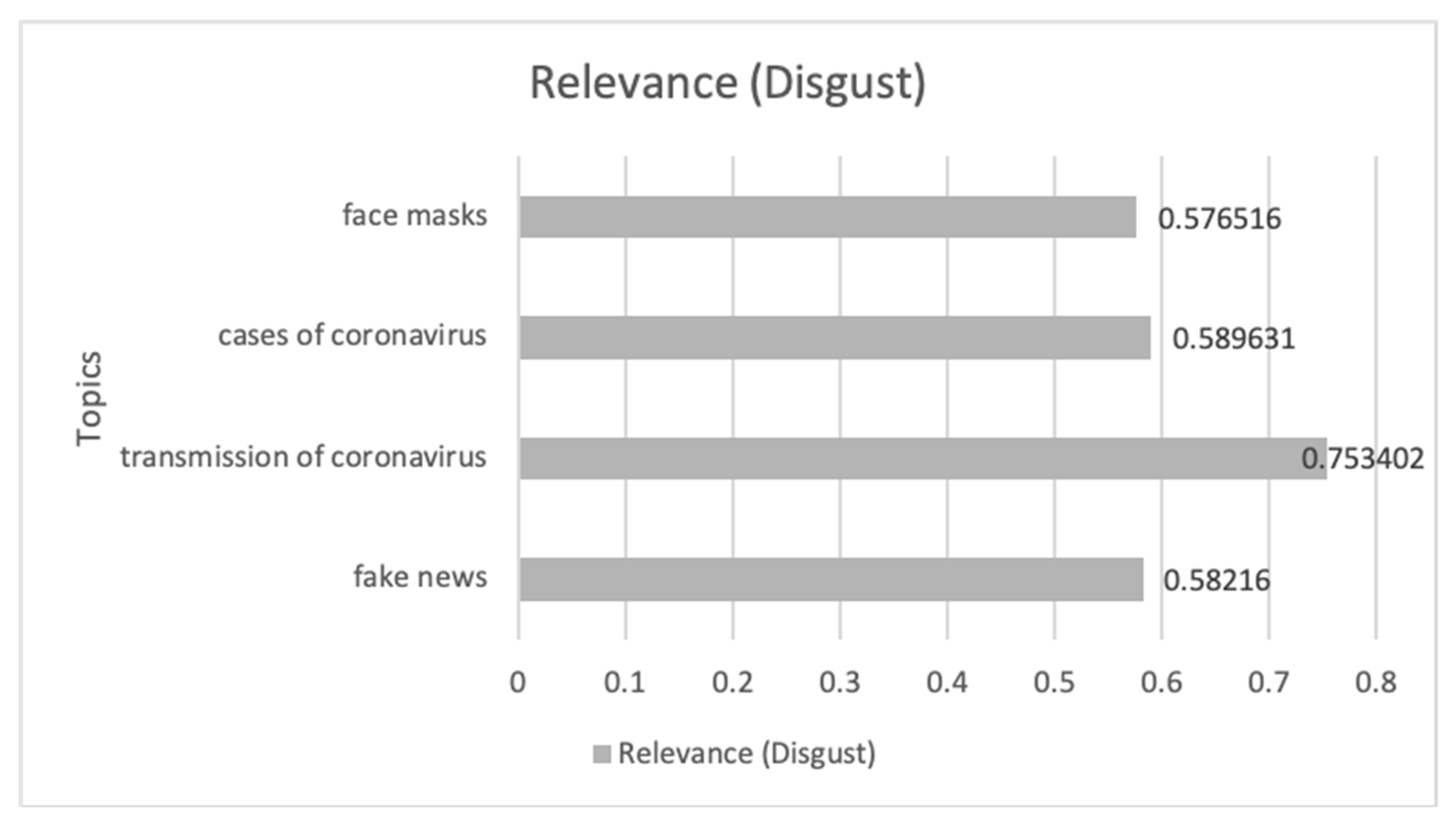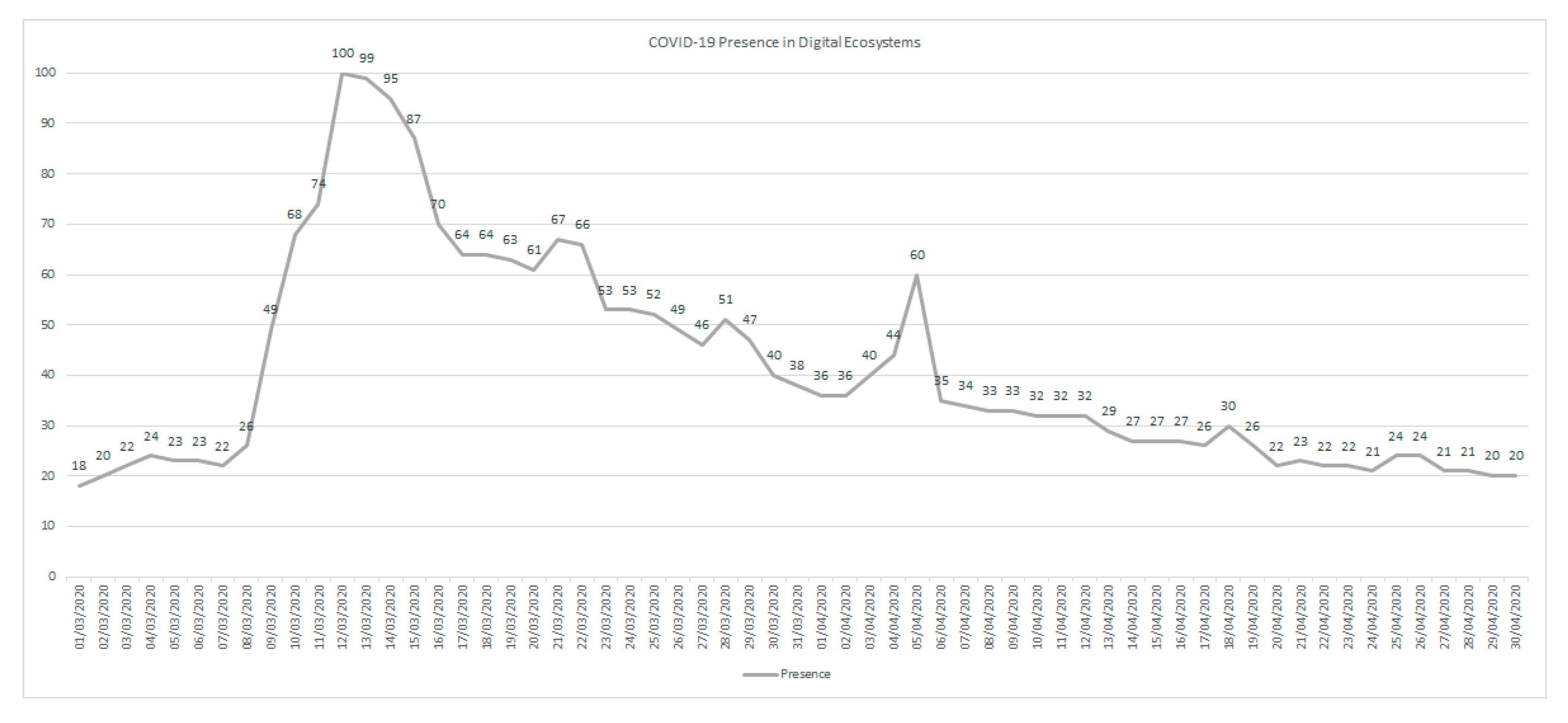1. Introduction
The outbreak of the coronavirus disease (COVID-19) was first reported by the Wuhan Municipal Health and Safety Commission (Hubei Province, China) on 31 December 2019. One month later, the Emergency Committee of the International Health Regulations [
1] declared the new coronavirus outbreak as a Public Health Emergency of International Importance (PHEI) at its meeting on 30 January 2020 [
2].
Five months after the official announcement, the virus has infected more than 6,193,548 people worldwide and killed around 372,479 people [
3], bringing catastrophic consequences for society [
4], completely collapsing health systems in different countries [
5] and generating a strong economic recession worldwide [
6].
Throughout the history of mankind, societies have been faced with crises of various kinds and of very diverse natures, such as civil conflicts, financial crises, crises caused by the management and export of energy resources or emergencies caused by the impact of diseases and epidemics, among others [
7]. It is only necessary to recall some of the events of the past 20th century to be able to appreciate how crises have conditioned our existence and have modified our way of living and understanding the world around us [
8,
9].
However, the current crisis caused by COVID-19 is developing in a social–technological scenario that is unprecedented for society. We are in a highly globalized world, where migration flexibility, free transit between countries, and the development and use of Information and Communication Technologies (ICTs) are fully established [
10,
11]. In addition, we must highlight the growing interconnection between the world’s economies, which is reflected in the flow of goods, capital, people, and ideas [
12]. These facts and others associated with contemporary societies are making us face an old enemy of humanity as they are in this case, viruses such as the COVID-19 pandemic in a completely different context, and it is in this new scenario where areas such as communication, and in particular crisis communication, have become essential to manage and combat crises [
8,
13].
Crisis communication is fundamental in risk situations since it is responsible for maintaining an accessible and transparent relationship in the different flows and transmissions of information and communication, which is the premise of collective action. However, crisis communication is not only about transmitting knowledge but also about finding ways of transmitting comprehensive information that reflects uncertainty and enables the public to make fact-based decisions about our case, about health [
14,
15,
16].
The population does not always understand the complex professional knowledge about risk, so crisis communication through its professionals must facilitate the understanding of such knowledge in content in a simple and explicit form so that it can be easily understood by all citizens, regardless of their social, cultural or educational level. Society needs to feel informed by qualified experts; otherwise, they will seek out the information, which may be unproven, rumored, or simply false news. Likewise, risk communication must maintain a balance between being neither too centralized nor too decentralized and allow the permeability of information between the different layers of the information process, and all with the ultimate goal of being identified by the population as a trusted source of information [
17,
18]. In this process, the different stakeholders must fulfill their responsibility according to their roles and keep the communication network functioning.
Without a doubt, crisis communication is fundamental when it comes to transmitting security, calmness, and credibility. It oversees forging emotions that generate value to better face the different crises that occur. If this is not the case, it produces an effect of mistrust and lack of credibility in the population, directly affecting the emotions of the target audience. For Covello et al. (2001) [
19], risks aroused by feelings of sadness, fear, anger, or mistrust will be perceived as greater than the risks that are not. For government institutions or agencies that lack credibility and trust, such feelings will increase in the face of trusted agencies or institutions. In this line, the public health risks associated with pandemics, which produce deaths or have irreversible consequences in a country, will generate a greater feeling of lack of protection and loss of trust among citizens [
10,
18,
19].
One way of estimating, measuring or assessing crisis communication would be through the study of the emotions and feelings expressed by the public, and to do so without being questioned, to avoid what Arrow [
20] calls the “strategic aspect of decisions”, where the person being questioned adapts his or her response to his or her interests. It is in this context that social media becomes essential, as it is a virtual space where society usually expresses itself freely (they are not asked), becoming an essential source from which to gather such information.
The aim of this research work is to analyze the crisis communication in the field of public health that has been carried out during the COVID-19 pandemic, by measuring the emotions that have been generated in the population, and the crisis communication strategy that has been carried out by the Spanish Government.
The example of Spain was selected as a case study. Under Royal Decree 463/2020 of 14 March Spain declared a state of alarm for the management of the health crisis caused by COVID-19 [
21], positioning itself as one of the countries in the world most affected by the pandemic, with the highest number of cases per million inhabitants, adding up to a total of 239,638 confirmed cases of COVID-19 by PCR and the second-highest number of deaths according to population, with a total of 27,127 deaths [
22].
Figure 1 shows the trend in reported cases of COVID-19, deaths, and recoveries patients between 25 February 2020 and 29 May 2020. It is verified that the highest level of cases by coronavirus was on 31 March 2020 and deceased people on April 1. After these days, the curve of new infections and deaths trended downward and recovered people were increasing.
Face masks were a problem, especially at the beginning of the pandemic. Initially, they were not available to the general population, so they were only used for those most at risk of infection, such as health care, security forces, and the military. The Government of Spain was responsible for the purchase and distribution of face masks to the autonomous communities.
Figure 2 shows the distribution of face masks carried out by the government between 10 March and 29 May. Madrid and Catalonia, with the highest number of infections from COVID-19, were where most face masks were distributed.
This research work represents a pioneering challenge in the field of risk communication research. During the months of March and April 2020, various digital ecosystems were analyzed, and a sample of 106,261 communications was obtained through the analysis of APIs and Web Scraping techniques. The study analyzes, through social media, how risk communication management has been affected during the COVID-19 pandemic, led by the main governing bodies, health organizations, and the collaboration of the main stakeholders (media). Moreover, the study investigates how COVID-19 has impacted society and the various effects on the emotions and feelings (anger, disgust, sadness, and fear) of the population [
25].
Key variables in risk communication theories and the risk perception model are identified and were introduced into the framework of strategic health risk communication, to assess how the risk content of COVID-19 was or was not communicated to the population.
The work is organized as follows: in
Section 2, the materials and methods are presented; in
Section 3, the results are obtained; and in
Section 4, the discussion and conclusions finish the work with future research lines.
2. Materials and Methods
This research collected data directly in real time from the main media and digital ecosystems: Twitter, YouTube, Instagram, official press websites, and internet forums. The data collection started on March 1 and finished on 30 April 2020. A sample of 106,261 communications was obtained. These data were comprised of written communications related to the COVID-19 pandemic in Spain. The collected communications were anonymized, eliminating authorship data, location, source, images, hyperlinks, and non-textual components, to leave only the text corpus.
The study universe comprised thirty-two million Spanish citizens, accounting for roughly 68% of the Spanish population that are considered as social media and internet users, according to the National Institute of Statistics of Spain (INE) data (forecast on 1 July 2019) [
26]. Each internet user in Spain had the same odds of being included in this research.
On the one hand, the inclusion criteria were:
The communication makes explicit reference to the COVID-19 pandemic in Spain.
The communication is public and can be viewed without the need for a subscription to the data source or explicit permission from the sender of the communication.
The author’s reported age, when available, was over 18 years old as of the start of the end of the study (30 April 2020).
The communication is written in Spanish.
On the other hand, the exclusion criteria were:
The communication does not come from an advertising campaign.
The communication has not been generated by automatic procedural methods (bots, fake posts, among others).
One of the most usual problems that we must deal with when using information from digital ecosystems is detecting spammers, fake information generated by bots, which tries to influence or modify the perceived opinion on existing information. To detect and discard this type of information we have implemented different types of algorithms based on Support Vector Machine (SVM) techniques which can detect the patterns of this kind of communications, such as the age of the account (in days), the number of comments from the account, follower/following ratio, and the ratio of messages containing URLs. To prevent the effect of spammers, in this work we implemented and applied filters previously defined and tested in other scientific works [
27,
28].
The emotion information from each communication was extracted employing the natural language analysis tools provided by the IBM Watson Analytics service [
29]. The emotional intensity was measured in a 0 to 1 scale, where 0 represents the complete absence of this emotion; and 1 represents an absolute high intensity of the emotion. In total, this study measured the emotional intensity of four primal emotions—anger, fear, disgust, and sadness.
To detect and measure the primary emotions in this study we used the services provided by the IBM Watson system. Watson is a cognitive computing platform that combines a DeepQA architecture, with AI algorithms and Big Data to solve questions in the domain of natural language. This platform offers a wide range of services including Discovery, Knowledge Studio, Language Translator, Natural Language Classifier/Understanding, and Personality Insights among others.
Watson has an overall precision of 97% in natural language processing and has been widely compared with other systems, as well as with humans, and in both cases, it has obtained very satisfactory results. For this reason, this system has been widely used in different scientific works where it has further proved its capabilities on Natural Language Processing (NLP) tasks [
30,
31,
32,
33,
34,
35].
In this work, we made use of the Natural Language Understanding service from the IBM Watson platform which, given an input text, provides an analysis of syntactic characteristics as well as information on categories, concepts, emotions, entities, keywords, metadata, relationships, and semantic roles.
The reliability of the resultant emotion information was tested using the Interval Majority Aggregation Operator (ISMA-OWA) [
36], which is designed for Decision Making in Social Media with Consistent Data, leveraged by the combination of computational intelligence and Big Data techniques [
37].
To obtain representative results, when analyzing with information extracted from digital ecosystems, it is important to ensure a correct representation of such information and its quality.
When people express opinions in communications, they do not do so in numerical value with a fixed scale, they use natural language expressions such as “this is great” or “this is not so good”, so we employed the intervalar representation proposed in [
36,
38] instead of a numerical scale. The main advantage of this approach is that intervals represent the information within communication in a way that is more similar to the way people express themselves in digital ecosystems, thus reducing the loss of information associated with forcing linguistic data to a hard-numerical scale.
Furthermore, regarding information quality, an important aspect that we must consider when assessing the validity of this information is to ensure that such information has been expressed with knowledge of the topic at hand and not at random. Another advantage of the usage of an intervalar representation of digital ecosystem data is the availability of consistency indices that can be applied to the matrices obtained from communications to detect inconsistencies derived from uninformed opinions. For this purpose, in this work, we employed the CI+ index defined in [
39].
The frequency of the words comprising the sample of communications was calculated using a natural language processing algorithm implemented in Python 3, using the Natural Language Toolkit (NLTK) [
40]. Moreover, the emotion polarity (positive or negative) was measured using a multilayer perceptron model, trained to classify the emotional weight of written communications [
38,
41].
The Python NLTK library is an open-source programming library for working with natural language data which incorporate functions that allow for the determination of the frequency of words in a text while discarding stop-words, that is words that are very common to a language but do not convey any significant information such as “the”, “a” and “very”. Furthermore, the NLTK library serves as a pre-processing tool to use other Artificial Intelligence tools such as Artificial Neural Networks such as the multi-layered perceptron that we used in this work to detect the polarity of communications.
A multi-layered perceptron (MLP) is a widely used artificial neural network architecture that utilizes a technique known as supervised training to learn how to differentiate data that is not linearly separable. In this case, we trained our MPL with a set of communications created by the Spanish Society for Natural Language Processing (SEPLN) which contains over 100,000 natural language texts tagged with the polarity of each communication, that is, each communication contained metadata that indicated if the message was positive or negative. There are other techniques for Natural Language Sentiment Analysis, such as Naïve Bayes, or Support Vector Machines, but we opted for the MLP approach since it can learn complex relationships and it does not enforce any sort of constraint concerning the input data [
42].
To further improve the qualitative analysis, the above-mentioned information regarding the volume of communications, the frequency of words and the emotion expressed by each communication was contrasted to determine the information pathways between mass media, government, political parties, employers’ confederation, non-governmental organizations (NGOs), trade unions, the World Health Organization (WHO), among others. This approach provides a graphical representation of the information fluxes about the COVID-19 disease in Spain.
For the analysis of the messages emitted by the Spanish government, a content analysis of all press releases during the period of study was carried out. Messages were classified as positive, neutral, or negative by selecting the most significant words from them. The frequency of repetition of these words was another objective of this content analysis. The result has been shown through a word cloud representative of the emotions and feelings expressed by the government in its press releases.
The analysis of content permits inferences to be reproduced based on specific characteristics identified in the messages [
43,
44]. This type of analysis allows for the discovery of tendencies and the revelation of differences in content communication. Likewise, this allows the comparison of messages and means of communication, and the identification of intentions, appeals. To this effect, value and frequency analysis were used [
45].
3. Results
3.1. Communication Structure with Stakeholders
Since the beginning of the pandemic, the structure organized by the government has involved relations between the Spanish government (the Health Alert Coordination Center, which is part of the Ministry of Health) and the governments of the autonomous communities, the National Epidemiology Center, the National Microbiology Center and the international organization’s World Health Organization (WHO), the European Disease Control Center and the European Commission [
46].
To raise awareness and inform public opinion, the Spanish government designed a communication strategy articulated in four actions that had the use of the mass media as channels of transmission of COVID- 19 information as a main objective:
- (a)
Weekly appearances of the President of the Government.
- (b)
Daily press conferences chaired jointly by the following ministers: Minister of Health, who is responsible for the state of alarm decreed in the country; Minister of Defense, who is responsible for the military forces; Minister of the Interior, who is responsible for the State security forces and Minister of Transport. All of them were accompanied by experts in each of the areas. The ministers sent out a political message and the experts went into detail about the actions being taken. With a press conference format, online questions from the main Spanish and foreign media were admitted. However, this format underwent the first modification after the second week being responsible for the press conferences the so-called “Technical Committee for monitoring the coronavirus pandemic in Spain” consisting only of experts of the different ministries. On 25 April, there was a new restructuring of the press conferences, leaving only the director of the Health Alert and Emergency Coordination Centre of the Ministry of Health as the health expert. This last change is censored by the communications media.
- (c)
Press release. After the appearance at a press conference, the communication department of the Ministry of Health sent a press release to all the media.
- (d)
Interviews with ministers. Another of the government’s actions was to make its Cabinet available to the media for interviews.
To reinforce the previous actions, on March 15, the state government launched the advertising campaign #EsteVirusLoParamosUnidos. This campaign is adapted for television, press, radio, outdoor advertising, and social networks.
Figure 3 shows the main communication flows established in the government’s strategy. Except for social networks and outdoor advertising that are directly focused on citizens, the rest of the information is conducted through the media.
In Spain, the decreed state of alarm requires the total confinement of the population. Royal Decree-Law 10/2020, of 29 March 2020 [
47], establishes the minimum essential services of first necessity such as all those necessary for the supply of food to the population. The minimum distance was made to be one and a half meters. Except for these cases, the rest of the population must carry out their work by teleworking, and if this work is not possible, the government approved Royal Decree-Law 8/2020 of 17 March on extraordinary urgent measures to cope with the economic and social impact of COVID-19 [
48], which regulates emergency procedures to combat the economic and social impact of the pandemic, denominated as the Temporary Employment Regulation File (TERF). The number of workers affected by the TERF was two million on 3 April [
49]. The high number of TERF requests blocks the administration from responding to the citizens with a decrease of the collection of these aids and the decapitalization of these workers in some cases without the possibility of paying the rents of their houses or simply buying the necessary food for the family. Non-Governmental Organizations and food banks have a crucial role to supply the neediest in the population. During confinement, the media are not left out. Their workers follow their work from their homes. On televisions, these measures cause programs to be suspended and replaced by new programming offering coronavirus specials. These programs have a structure of news, interviews with experts or politicians, discussion programs or talk shows where COVID-19 and the situation that citizens are experiencing are analyzed.
Due to the uncertainty of the situation and the isolation in their homes, citizens are consuming more television. Thus, the month of March and later April became the months with the highest television audience in Spanish history. March data show an average consumption of 282 min per person per day (4 h and 42 min). The average number of people who had watched TV for at least one minute a day was 369 min (6 h and 9 min) [
50]. The progression in the television audience continued in the month of April with numbers never seen in the conventional Spanish television with 302 min (5 h and 2 min) and 395 min (6 h and 35 min) respectively. In addition to television coverage, 33.6 million Spaniards consumed this medium daily, representing 74.2% of the population [
51].
The serious effects on the economy caused by the crisis determine that new actors acquire an active role in communication by modifying the initial panorama organized by the government. Political parties, the Confederation of Employers and trade unions are configured as sources of information. These new stakeholders also offer interviews to the communication media, organize press conferences, and finally communicate with citizens directly through social media (see
Figure 1).
Therefore, the stakeholder structure created by the government is increased by other social actors who have their own opinion on the management of the pandemic. All of them have in common the use of the media to convey their messages to the citizens, converting these media as the main interlocutors with the population. The high consumption of television makes it the main means of information used by citizens.
Public and private televisions in Spain broadcast the press conferences of the different stakeholders and the appearances of the President of the Government. This is referred to in
Figure 1 as “news”.
The different ideological tendencies of the television channels in Spain mean that their interview programs with experts and television debates do not follow a single argument in support of the government’s management. These messages feature contradictory opinions that the media convey to the public as interviews, discussion programs, and talk shows, which increase uncertainty among citizens (
Figure 3).
3.2. Comparison between the Tone of the Messages Sent by the Government and the Feelings and Emotions Generated in the Population
In a public health crisis like the one Spain is experiencing, a transparent and empathetic communication style would generate citizen confidence and would be more effective if politicians and experts unanimously tried to stimulate the population to take a positive stance towards the pandemic and the health and economic alert measures imposed by the government. Although the generation of trust must be essential in a crisis, the analysis carried out shows the public’s distrust of scientific experts and government representatives for a variety of reasons such as access to conflicting sources of information, contradictions in scientific reasoning, changes in decision-making and, above all, political confrontations.
Trust and credibility, demonstrated through empathy, experience, honesty, and transparency, are essential elements of public health crisis communication [
18].
Figure 4 analyzes the messages transmitted by the Ministry of Health in its press releases between March and April. In green, the positive messages were determined, in black the neutral ones and in red the negative ones. The word size indicates the frequency of repetition in the press releases. As can be seen in the word cloud, the negative word “COVID” is the most used by the government in its communications. This is followed at a distance by “coronavirus” and “health crisis” with a dark red color that indicates their use in negative messages, but also in neutral tones. “Social Networks” is a neutral term used mainly to explain the social network campaigns implemented by the government. It is followed by “patients” and “nursing home”. However, the most remarkable thing about this word cloud is its words in the green. The communication made by the communication office of the Ministry of Health has always wanted to give a positive view in all their messages, with “Government” as the most used word, followed by “face masks”, “Ministry of Health” or “test”. This could indicate a lack of transparency about the situation the country was going through. None of these press releases refer to either the infected or the dead. Attempts are made to give a protagonist role, at times, to all the actions carried out by the government.
In contrast,
Figure 5 shows the results of the 106,261 listings made on social media between the same months and shows the feelings and emotions of the population. On this occasion, the word “cases” is the most representative that reflects the number of infections suffered in the country. It is followed by the word “crisis”, which represents the public health crisis but also the economic one. The terms “COVID” and “Coronavirus” are strongly represented, as well as “Spain” and “world” which represent the concern of the population in the face of a pandemic of this magnitude. “Casualties” is another of the most significant words and is indicative of all those people who have benefited from the TERF and who have not yet received the promised aid from the government. The positive messages sent by the government and its experts are counterbalanced by the volume of opinion generated by the media and especially the generalist televisions.
Some reasons include political parties’ criticism of the government’s management, contradictions of the experts, the constant increase of infected and dead, Spain being among the most affected countries, the state of confinement suffered by society not always in the best conditions, the anxiety of not having financial resources, the population’s insecurity in the face of a public health crisis with global effects that are caused by millions of infected people and hundreds of thousands of deaths in the world.
All these reasons generate negative feelings and emotions, causing uncertainty and fear among citizens. Digital ecosystems reflect this trend in a word cloud with a markedly negative character (
Figure 5).
3.3. Communications that Generate the Greatest Emotional and Sentimental Impact on Society during the COVID-19 Pandemic
The communications that have the greatest impact on four of the main emotions of the population—fear, sadness, disgust, and anger—are presented. The study has allowed for the determination of the reaction of the population concerning the COVID-19 pandemic and the crisis communication carried out by the government, determining the themes and the feelings of the communications associated with the crisis communication.
To this end, the emotion graph corresponding to the period of study is first determined, determining the peaks of emotion that are significant, and those news patterns that generate greater presence and reach in digital ecosystems. Secondly, the topics that have most influenced these emotions are analyzed and the patterns that generate them are concluded.
3.3.1. Association of Disgust Communications Connected with Management and Its Emotional Impact during COVID-19 Pandemic
Figure 6 shows the evolution of the Disgust emotion during the study period, where nine peaks can be distinguished where the emotion shows a significant increase.
In
Table 1, the communications that had the greatest impact on this increase are analyzed in chronological order from 1 March 2020 to 30 April 2020. From these communications, the management of the pandemic is the general theme that most impacts the emotion treated. Aspects such as: blaming the pandemic on groups that can be grouped by religion, sex, use of the security forces to censor the population’s opinion; lack of care for weak sectors such as the elderly; and the purchase of health material are the conversations that predominate in digital ecosystems.
Finally, in
Figure 7, the most relevant topics and their impact value on the emotion of disgust are shown. This shows how the management of masks, censorship in the news, and the transmission of the virus in general and especially in groups of elderly people, predominate in this emotion.
3.3.2. Association of Fear Communications Related to Death and Its Emotional Impact during COVID-19 Pandemic
Figure 8 shows the evolution of the Fear emotion during the study period, where five peaks can be distinguished, where the emotion shows a sustained decrease over time.
In
Table 2, the communications that have had the greatest impact on this temporal progression are analyzed in chronological order from 1 March 2020 to 30 April 2020. Of these communications, the rapid growth of the pandemic in Spain, the overwhelming social security system, and the economic collapse caused by the COVID-19 pandemic are the general themes that have the greatest impact on the emotions addressed. Aspects such as border closures, death forecasts, job losses, defective health material, the Spanish government being overwhelmed, and deaths in residences are the conversations that predominate in digital ecosystems.
Finally,
Figure 9 shows the most relevant issues and their impact value on the emotion Fear. This shows how interest in the state of alarm, the transmission of the virus, emergency health material, and deaths of family members predominate in this emotion.
3.3.3. Association of Anger Communications Related to Lack of Foresight and Its Emotional Impact during COVID-19 Pandemic
Figure 10 shows the evolution of the Anger emotion during the study period, where eight peaks can be distinguished where the emotion shows sustained growth over time.
In
Table 3, the communications that had the greatest impact on this temporal progression are analyzed in chronological order from 1 March 2020 to 30 April 2020. From these communications, it can be seen that the loss of employment due to lack of foresight, the delay in activating the health alert, and the opacity in the acquisition of health material by the Spanish Government during the crisis by COVID-19 were the driving themes in this case. Aspects such as disinformation for de-escalation, the collapse of the health system, the dubious data on the number of infected and dead people, and the control of the media proposed by members of the Spanish government are some of the conversations that predominate in digital ecosystems.
Finally,
Figure 11 shows the most relevant topics and their impact value on the Anger emotion. This shows how the interest in deaths by a coronavirus, the resources to cure the virus, the diagnosed cases, and the rate of infected, predominate in this emotion. This shows that the lack of prevision predominates in this emotion.
3.3.4. Association of Sadness Communications Related to Safeguarding and Its Emotional Impact during COVID-19 Pandemic
Figure 12 shows the evolution of the Sadness emotion during the study period, where eight peaks can be distinguished where the emotion shows sustained growth in time.
In
Table 4, the communications that had the greatest impact on this temporal progression are analyzed in chronological order from 1 March 2020 to 30 April 2020. Of these communications, censorship during COVID-19, die of coronavirus, coronavirus patients, infection of coronavirus, and the delay in the incorporation to the labor activity are the general themes that have the greatest impact on the emotion dealt with. Aspects such as political interests, entities that the security of the population due to the virus, sale of necessary material by the COVID-19 pandemic to foreign countries when it is necessary for Spain, healthcare workers exposed to infection by defective health care material are some of the conversations that predominate in digital ecosystems.
Finally,
Figure 13 shows the most relevant topics and their impact value on Sadness’s emotion. This shows how the interest in deaths by COVID-19, patients by COVID-19, the elderly, and infected workers, predominate in this emotion.
3.4. Volumes and Flows of Information during the COVID-19 Pandemic
As shown in
Figure 14, the highest presence of the term COVID-19 occurred in the early stages of the pandemic, reaching its highest value on the date when the Government of Spain announced that it would implement the state of alarm and confinement of the population. From that date onwards, there is a downward trend in the use of this term, until 5 April, when an extension of the state of alarm is announced.
During this time, the use of the term COVID-19 followed a decreasing tendency, motivated by the emotions that the population experienced. If at the beginning, the great concern was the virus, the management carried out by the government, the deaths, the social actions, all caused a change in the terms used in the digital ecosystems, with the virus being a secondary problem about the subjects that influence the emotions.
4. Conclusions
The spread of pandemics causes uncertainty and fear among the population. This type of crisis, by not adjusting to specific limits, makes risk communication more critical when designing effective strategies [
52,
53]. Effective risk communication means that all messages can be presented and shared with the population in a transparent, credible, and easily understood communication process. Its main objective is to reduce the knowledge gap between the issuers of information and its recipients to adjust public behavior to proactively address risk [
54,
55]. The essential elements for reducing risk and avoiding panic among the population are rapid action by public health organizations and truthful and honest information from governments [
56].
Even though Rodin et al. [
57] indicate that in the case of a crisis in public health, stakeholders are structured in international and national public health organizations, national governments, non-governmental organizations, the media, and citizens, the serious situation experienced in Spain has led to new actors taking on a decisive role in communication, modifying the organizational structure originally designed by the government. Therefore, the little or no dialogue between the government and the social actors that make up the map of the main publics involved in the COVID-19 crisis with different points of view in the face of the pandemic leads to the conclusion that the structure of the stakeholders involved does not determine singular, clear and efficient communication that gives confidence to society.
The analysis of the government’s communication management shows that the messages emitted, mostly with a positive tone, have been offset by a flow of information from other actors in disagreement with government policies. These are mainly channeled by the media and especially the generalist televisions. In Spain, three out of four citizens have used generalist television to keep themselves informed during the pandemic. Television is also the medium most used by Spaniards to seek out different expert opinions. Finally, seven out of ten Spaniards say that the diversity of journalists, approaches, and news items on generalist television help them form their own opinions [
58]. This information, sometimes contradictory, that reaches the population makes uncertainty and panic be perceived by the citizens through digital ecosystems.
There are significant differences between the feelings and emotions of the public about COVID-19 analyzed in this study and the tone of the risk communication carried out by the Spanish government and the committee of experts represented in
Figure 4.
Risk communication has very close links to the behavioral health issues that affect tens of millions of people. Fear and anxiety about a new disease and what could happen can be overwhelming and cause strong emotions in the population. Through the monitoring of the emotions and the general sentiment of the people across social media about the COVID-19 pandemic reveals that:
Research shows that the current COVID-19 pandemic is creating an added strain on our emotional well-being.
Topics and themes connected to COVID-19 include Management, Social Collaboration, Death, Safeguarding, and Lack of Foresight. Those are strongly related to health and finances, uncertainty about the length of the quarantine, anger over the loss of control, fear of death, illness, loss of employment, economic instability, loss of loved ones, discontent with the Spanish government, transparency, a sense of loneliness and, ultimately, fear of the unknown.
Research results also demonstrate a lot of mixed feelings. It is observed that the same news, information or media communication generated peaks in different emotions, indicating that they are very mixed between sadness, disgust, anger, and fear.
Presence analysis reveals that the term COVID-19 received the highest presence during the early stages of the pandemic, reaching its highest value on the date when the Government of Spain announced that it would implement the state of alarm and confinement of the population. From that date onwards, there is a downward trend in the use of the term COVID-19.
During this time, the use of the term COVID-19 has followed a decreasing tendency, motivated by the emotions that the population has experienced. Initially, as reflected in the study, only the virus (term COVID) was of interest, and later, the consequences and direct impact of the virus on daily life.
